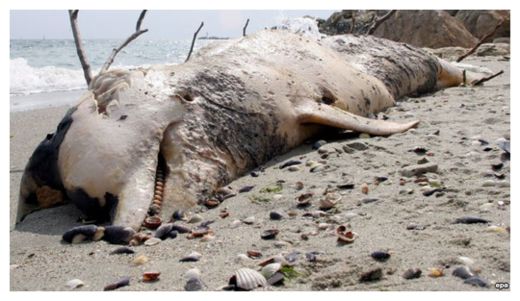
© EPAAn increasingly common sight on Russia's and Ukraine's Black Sea coast.
Hardly a day goes by in Sochi, Russia's picturesque Black Sea resort, without a dead dolphin washing up on the beach.
With the tourist season just kicking off, the unexplained deaths have yet to draw much scrutiny.
But environmentalists are increasingly alarmed. The dolphin carcasses are also turning into a real holiday spoiler for vacationers drawn to the region's scenic beaches and pristine vistas.
Russian tourist Aida Kobzh was shocked to discover a group of dead dolphins last week at her local beach in Sochi.
"Everyone stood there and stared at the dead little dolphins lying belly up. Poor creatures!" Kobzh says. "There were some on the beach but also in the water, they were floating there, dead.
Little Official InterestThe dolphins started washing up along Russia's Black Sea coast several weeks ago. They have also been spotted on Ukrainian shores.
Environmentalists are now talking about the biggest dolphin die-off to date in the region, with an estimated 300 animals dead so far.
Local authorities have made no serious attempt to investigate the deaths, saying the animals are too decayed by the time they reach the shore for laboratory tests to be conducted.
Officials have blamed poachers and fishing nets. They say the unusually cold winter has driven dolphins from the Sea of Azov to the warmer Black Sea.
Some experts, like local zoologist Konstantin Andramonov, point to a possible killer virus.
"The death toll is constantly growing, unfortunately," Andramonov says. "We are now witnessing the same in Ukraine. There is a hypothesis that we are dealing with an infectious disease that occurs roughly every 20 years."
Ecosystem In DangerMost experts, however, believe the real culprit is ever-increasing pollution in the Black Sea region.
Valery Brinikh, who works for the prominent environmental group Ecological Watch, says the scale of the dolphin deaths belies official accounts faulting poachers and fishing nets.
"This happens every year in Sochi -- sometimes there are more deaths, sometimes fewer," Brinikh says. "But the scale this time suggests unnatural causes, probably sea pollution or a loss of orientation of the dolphins, which can also be linked to pollution."
Environmentalists say pollution levels have risen dramatically around Sochi since the city was selected to host the 2014 Winter Olympic Games.
They have long warned that unbridled construction is inflicting irreparable ecological damage to Sochi's unique ecosystem.
Olga Noskovets, a local ecologist, suspects that the authorities are perfectly aware it is pollution that is killing the dolphins.
She says pollution levels are highest in areas close to the Olympic construction sites that dot Sochi and its outskirts.
Black-And-Blue SeaAccording to Noskovets, the most affected area is Sochi's Lazarevsky district, where tourist Aida Kobzh recently spotted the dead dolphins.
"The biggest hazard is posed by a river that runs through the Lazarevsky district, an area with a high concentration of sanatoriums, including for children," says Noskovets. "The infamous Olympic dump lies nearby, and it has no waste-treatment system. This small mountain stream, which used to have fish, is now cloudy, brown and foamy. It collects waste and carries it to beaches that once counted among the most beautiful in the area."
Noskovets says the dolphin die-off should act as a wake-up call. She says the authorities must urgently sound the alarm and warn visitors about the health hazards of bathing on certain Black Sea beaches before the tourist season reaches its peak.
"If sea creatures that are adapted to life in the sea react this way, what will the consequences be for humans?" Noskovets says. "Every year, numerous people suffer poisoning incidents after bathing in the sea, and these are always blamed on food poisoning. It is a nasty lie from our authorities, who are afraid of telling the truth -- that the Black Sea is simply being poisoned."
[Link]